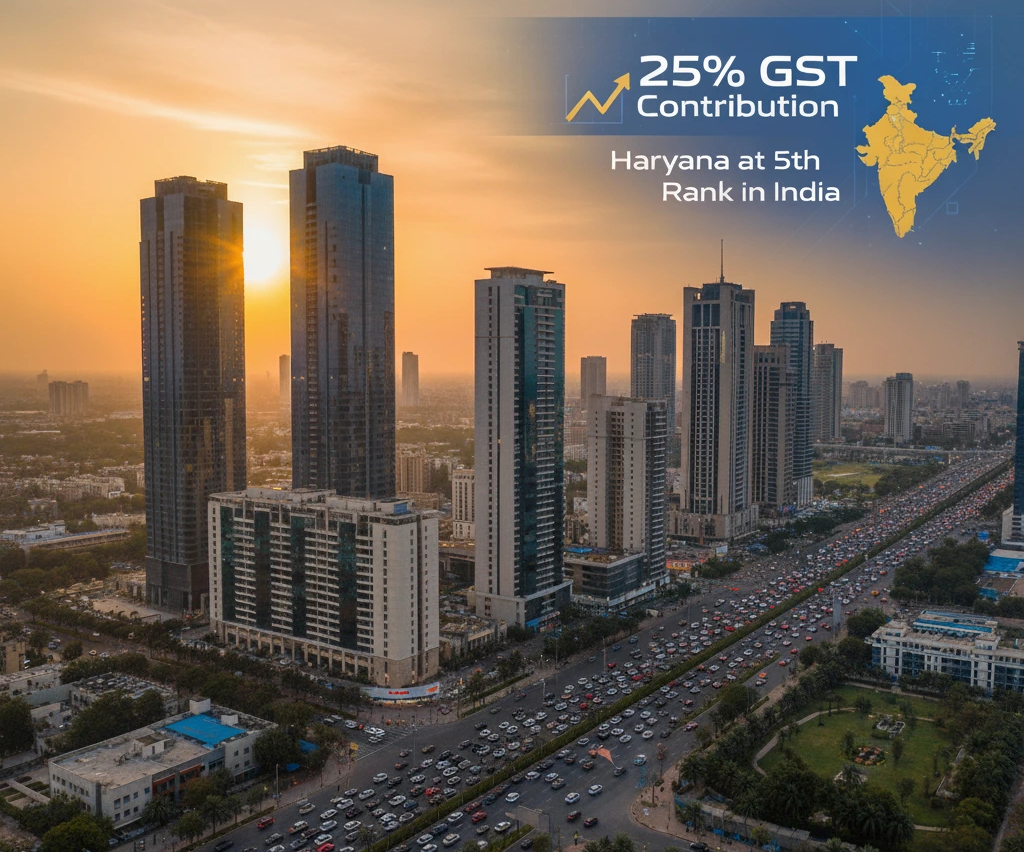Haryana’s GST Boom: Gurgaon Drives the State to 5th Rank
Haryana reached a historic high in the fiscal year 2024–25 by ranking 5th among Indian states in GST collections. The success was largely credited to the economic energy of Gurgaon, which alone accounted for nearly 25% of the state’s total GST revenues.
Haryana’s GST Growth: A Snapshot
Haryana’s net State Goods and Services Tax (SGST) collection jumped from ₹18,910 crore in 2018–19 to ₹39,743 crore in 2024–25, a whopping 110% hike. The state’s gross GST collection for the year 2024–25 stood at ₹1.19 lakh crore, a 16% increase compared to the last year. Interestingly, SGST revenue for 2024–25 was ₹23,000 crore, an increase of 14.4% from the last year. The first quarter of 2025-26 has already recorded a 17% year-on-year growth, showing an uptrend.
Gurgaon: The Economic Powerhouse
Gurgaon, commonly known as the “Millennium City,” is the major source of Haryana’s GST collections. The city’s strong infrastructure, booming Information Technology (IT) industry, and an abundance of multinational companies have made it a key economic center. The concentration of several industries and service industries in Gurgaon has greatly contributed to Haryana’s revenue collection.
Driving Haryana’s GST Surge
- Industrialization and Service Sector Growth
Haryana’s strategic emphasis on industrialization has encouraged a business-friendly climate. The state’s drive for the service sector, such as IT, finance, and real estate, has further increased the economic profile of the state. This diversification has resulted in greater taxable activity, thus boosting GST collections.
- Simplified Tax Structure
The implementation of a simplified GST structure with two primary tax slabs—5% and 18%—has streamlined compliance processes. This simplification has encouraged businesses to adhere to tax regulations, contributing to the state’s revenue growth.
- Enhanced Tax Compliance
The efforts of the Haryana government to enhance tax administration and compliance have been fruitful. The transparency and efficient collection mechanism pursued by the state have promoted a culture of compliance amongst enterprises.
Haryana vs. Punjab: A Comparative Analysis
As compared to adjacent Punjab, Haryana’s GST collections are significantly greater. The overall GST collection in Haryana was five times that of Punjab in 2024–25. This difference exists due to the diversified economy of Haryana, with important contributions from industries and the services sector, while the economy of Punjab is highly agrarian and agriculture is GST-exempt.
Expert Insight: SKJ Landbase

Sanjeev Singh, Managing Director of SKJ Landbase, shared his perspective: “Gurgaon’s role in Haryana’s GST growth highlights the importance of balanced urban development. As more businesses, IT firms, and real estate projects flourish, the city contributes not only to state revenue but also to creating employment opportunities. Strategic investments and efficient infrastructure are the keys to sustaining this momentum.
Future Outlook: Sustaining the Growth
To sustain and further drive GST revenue growth, Haryana intends to:
- Enhance Industrial Corridors: Building new industrial clusters to draw investments and diversify economic activity.
- Develop Infrastructure: Enhancing transportation and digital infrastructure to facilitate business activity.
- Facilitate Ease of Doing Business: Adopting policies that ease business setup and operations.
These strategic plans are intended to strengthen Haryana as a top performer in contributing to India’s GST revenue.
Conclusion
Haryana’s climb to the 5th rank among GST collections is a witness to the economic health and shrewd planning of the state. Gurgaon, which is full of buzzing economic activity, is instrumental in achieving this milestone. By sustaining industrial development, streamlining tax systems, and maintaining high compliance rates, Haryana can continue its climb up the GST collections rankings.




